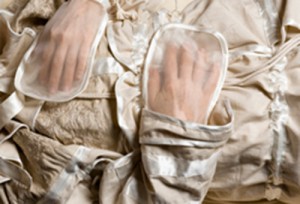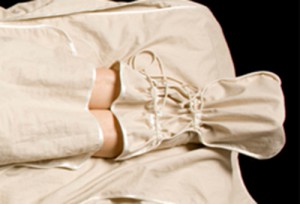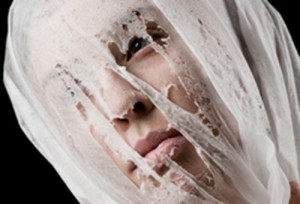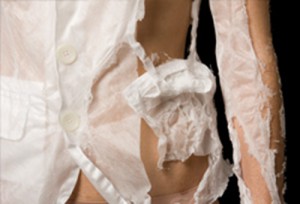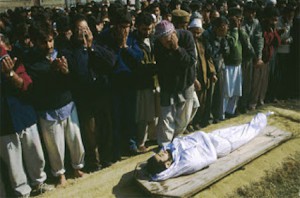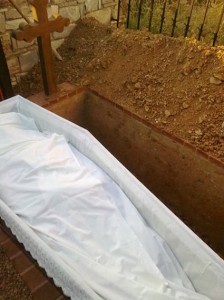The exhibition “The Future of Fashion is Now” in the museum Boijmans van Beuningen in Rotterdam included Pia Interlandi’s project “Garments for the Dead” in a depiction and a proposal of what fashion can be about in the future. Pia Interlandi, an Australian fashion designer and a former biology student, made a series of biodegradable garments for dressing the dead, in a way that respects the human body after death, but also the environment.
Interlandi’s work on “Garments for the Dead” started upon the death of her grandfather, when she was tasked with dressing his corpse in a suit. She then realized that the suit, and the last garment he would ever wear, was done without much thought and was even difficult to put on, so she came to the realization that the clothes where actually made for the living and were not suited for death. What is more, the materials used normally in these occasions are chosen for practical qualities such as longevity and expense, so the fabrics are mostly synthetic, like nylon and polyester. These fabrics can outlast a corpse, and actually prevent it from decomposing naturally. They are often non-biodegradable, and the chemicals used in their manufacture can leach out into the environment. Nylon manufacture creates nitrous oxide, a greenhouse gas 310 times more potent than carbon dioxide, and making polyester uses large amounts of water for cooling, along with lubricants which can become a source of contamination. Both processes are also very energy consuming.
http://www.greenchoices.org/green-living/clothes/environmental-impacts
Pia Interlandi started experimenting with soluble materials in relation to the human body. This exploration allowed her to dissolve the borders between the clothing and the skin, and explore our relationship to clothing as second skin. Ultimately, she made the burial garments since that would be the last skin which would be placed upon us, and literally and symbolically merge with us in our decomposition and dissipation into the earth.
“Death,romance and mystery were notions I aimed to embed within my own exploration of the shroud as it pertained to soluble fabrications.”
I find this material research particularly interesting as an artist, since I believe that the material choice is the beginning and the first source of my projects and that good knowledge of and feel for material create unlimited choices. It is always important to understand what is needed in the design and use the material in a way that supports the idea.
But it is also interesting for me as a former history and archaeology student, since dressing the dead has always been an important ritual in most human cultures. In ancient greek burial traditions, the dead were washed with oil and dressed by the female relatives in a type of clothing that befitted the deceased status in life. For example, if a person was recently married, he/she wore wedding attire in death. Sometimes they also put coins on their eyes or mouth in order to pay for the boat which would take them to the other side. Mayans sprinkled their corpses with the shavings of the red mineral cinnabar, since the color red was associated with death, and then wrapped in cotton for burial. Muslims still use burial shrouds which are made of white cotton or linen, and Orthodox Christians use a burial shroud which is usually decorated with a cross. In jewish traditions, shrouds were made of either white cotton, wool or linen, but the intermixture of two or more such fibers was forbidden.
A muslim, (https://www.youtube.com/watch?v=8mTXXnbYuVc)
a jewish (https://www.youtube.com/watch?v=E-UOilfKvKc)
and a christian orthodox funeral: (http://www.youtube.com/watch?v=Rz98pntRiAM)
Most of these burial traditions and materials are strongly connected to religion, but also strongly related to each other, and it’s interesting to see how universal some aspects are. It is actually a part of human nature, rather than merely a cultural habit. I also believe it’s not coincidental that in the modern western world, where religion is not as important as it used to be, or as it still is in some parts of the world, the rituals and the materials are also not so important anymore, and it’s done without much care. I remember my grandmother, who was a nurse but also dressed dead people numerous times, saying that it was really hard to put on the suits that the relatives chose and it had to be done the same day the person passed away, otherwise it would get too stiff. As Interlandi says, these suits are made for the living and are mostly manufactured and quickly chosen.
That is why I believe that Interlandi’s work on “Garments for the Dead’ is an innovative project in terms of respecting human nature and nature in general in a poetic way without any religious context, and mainly though the use of material. She has managed to focus on what is common for all humans, by using only what is important for the most tangible part of the burial, which is dissolving in the ground. Therefore, I believe that it couldn’t be more spot-on when put on display at “The Future of Fashion is now” in Boijmans, but also in relation to the section of the exhibition “Material and Experiment”, since it is a matter of material research in a way that the material itself can express an idea. Inspired by her work, I would hope that the future of fashion could be more focused on the qualities of the materials and our human nature, with no cultural, religious or non-religious barriers.
